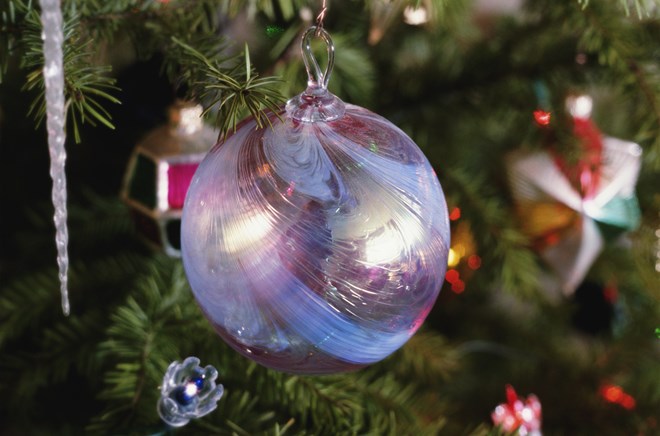This video is set in Brixton, London, and features interviews with local residents about their Christmas celebrations. Below the video, you will find seven lesson ideas to help you incorporate this video into your teaching.
Seven ideas on how to use this video with your class
The following lesson ideas can be used alongside the video Live from London: Christmas. You can use these ideas on their own, or you could group some of the activities together and choose to do them in whichever order you prefer. Each lesson idea has a recommended learner level. The transcript is attached under ‘Related files’ at the bottom of this page.
Some of the ideas can be used for flipped lessons. In this scenario, students can do tasks and preparatory work at home or in the school independently from the teacher for the following lesson. This allows more time for communicative tasks, teacher-led tasks or group-led tasks during class time.
1. Sound off
Level: Pre-intermediate (A2) to upper intermediate (B2)
Summary: Students watch the video without sound and make predictions about what is happening and what the people on the video might be talking about.
Objectives: to engage students and promote speaking, imagination and predicting skills; modals; agreeing and disagreeing
Instructions: Divide students into small groups and play the video with the sound turned off. Students have to use the visual prompts such as the montage (the opening scenes) and the expressions and mannerisms of the people in the video to make predictions about what the video is about and what the people in the video are saying.
Students can make notes as they watch before discussing their ideas in their groups. Have the whole class feed back to see the varied predictions before playing the video for a second time, this time with sound. Compare predictions with the actual video as a whole class.
2. Themed discussion
Level: Pre-intermediate (A2) to upper intermediate (B2)
Summary: Students use the four main questions from the video as a basis for a personalised discussion about Christmas.
Flipped: Your students could watch the video and do the worksheet at home so that in the following lesson the time can be used for comparing their answers and discussing the questions for themselves. You could then go on to do activity ‘Interview task’ steps 4–6 during class time.
Objectives: question forming; discussion; superlatives
Instructions: Place your students into pairs or small groups for this activity. Before playing the video, tell your students that the interviewer in the video, Luke, asks four main questions. Ask your students to write down the four questions that they hear (see below). Play the video.
Answers:
How would you describe a traditional Christmas in your household?
Is there a typical Christmas meal that you have?
What’s your favourite thing about Christmas?
What’s your least favourite thing about Christmas?
Play the video for a second time and ask your students to note down the answers given by each person in the video. Ask your students to compare their answers in groups and then feed back as a class.
Now ask students to ask and answer the questions, giving their own opinions/answers, in pairs or small groups. You could include a focus on superlatives. See below for examples.
My favourite thing about Christmas is …
The best thing about Christmas is …
My least favourite thing about Christmas is …
The worst thing about Christmas is …
You could also give the students further adjectives to turn into sentences about Christmas using superlatives, such as expensive, interesting, tiring, annoying, exciting.
3. Reordering
Level: Pre-intermediate (A2) to intermediate (B1)
Summary: Students watch the video through once, then arrange cut-up pieces of the transcript into the correct order. The transcript is attached under ‘Related files’ at the bottom of this page.
Objectives: listening for general understanding; memory recall practice.
Instructions: Print out the transcript (at the bottom of this article) and cut up into small manageable chunks.
Tell your students they are going to watch the video once, without further instruction. After watching the video, put students into pairs and hand out the cut-up transcript, asking them to arrange it into the correct order. Students re-watch the video to check their order is correct.
Finally, you can hand out the full transcripts to each pair to check their orders against. Whilst they read the transcript, ask the students to underline any language that is unfamiliar, and then have whole-class feedback, adding new language to the board.
4. True or false
Level: Pre-Intermediate (A2) to intermediate (B1)
Summary: Students given a list of true or false statements about the video content.
Objectives: listening for specific information
Flipped: Students can do this activity at home, as well as prepare their own true and false statements for use in the following class. You could then add the ‘Interview task’ activity to be completed in the rest of the lesson.
Instructions: Look at the statements below: some are true, and others are false. You can either write them up on the board or print out the worksheet under ’Related resources’ at the bottom of this page. You may wish to change the order of the statements, play the video first to make it more challenging or even using the transcript (found at the bottom of this page) you may wish to make your own true/false statements. You could pre-teach massive, goose, turkey, Christmas tree and the suffix -ish.
Statements and answers
Lydia spends Christmas at home with her family. [T]
Natasha describes her Christmas as a ‘small celebration’. [F] She says it’s big thing!
Kayleigh describes her dinner as massive. [T]
Kamilla’s family eat goose for dinner. [F] They eat duck.
Kamilla’s family dance around the dinner table. [F] They dance around the Christmas tree.
This dance is a Dutch tradition. [F] It’s a Danish tradition.
Patrick usually has his breakfast at 10ish. [F] It’s usually 11ish.
Lydia usually has turkey for Christmas. [F] She usually has goose.
Kayleigh’s least favourite thing about Christmas is shopping for presents. [F] It’s the washing up.
Kamilla’s least favourite thing about Christmas is getting all the presents organised. [T]
Additional idea: Ask your students to write their own true and false statements about their Christmas to swap with a partner.
5. Find the difference
Level: Pre-intermediate (A2) to intermediate (B1)
Summary: Students are given sections of the video transcript with slight differences to the video. As they listen they have to underline the differences, and then they correct them.
Objectives: listening for specific information
Flipped: Students can do this activity at home so that when they come in for the next lesson they do a more communicative task based on the theme of the video, such as ‘Themed discussion’.
Instructions: Below are six sections of script with the differences underlined, which you can either write on the board (remember not to add in the underlines!) or print out the worksheet at the bottom of this page under ‘Related files’. Alternatively, you can create your own scripts. Ask students to underline the differences as they watch the video for the first time. In pairs they correct the sentences.
Finally, watch the video for a second time to check answers.
Suggested differences
Natasha – I come from a very small family and my parents are from Guyana and in Guyana Christmas is a big thing. Lights, presents, food, food and more food.
Kayleigh – Traditional Christmas for me is a huge dinner, lots of friends and family, a fair amount of alcohol, presents.
Kamilla – So we do a duck for Christmas and we have friends round or we go and see friends and we also dance around the Christmas tree because that’s a Danish tradition.
Patrick – OK so usually it starts with breakfast about 11ish and smoked salmon, scrambled eggs and coffee. After that, a bit of a break, some present opening and then a long spread out Christmas lunch from 3 till 6 and then the drinking starts.
Lydia – We normally have a goose, a roast goose and chocolate pudding, and all the trimmings.
Natasha – I don’t like the fact that Christmas is started so early. I mean October you go into the shops and Christmas is in-your-face.
Answers: 1. quite a large, 2. massive, 3. family, family 4. Bucks Fizz (this is combination of champagne and orange juice – a popular celebratory drink in England) 5. Christmas 6. September
Additional idea: Ask your students to write their own statements with differences about their Christmas to see if their partner can guess them.
6. Vocabulary lesson
Level: Intermediate (B1) to upper intermediate (B2)
Summary: Students familiarise themselves with some colloquial language in the video.
Objectives: vocabulary building; speaking practice; inducing meaning from context; colloquial language
Instructions: Write the words and expressions below on the board, or print out the worksheet under ‘Related files’ at the bottom of this page.
It’s a big thing
massive
…ish
trimmings
a major gripe
in your face
Explain to your students that these words and expressions are in the video. As they listen they have to consider what they mean in context. Play the video, and then place your students in groups to see if they can come up with a definition for the new language. If they are still struggling, put the following definitions on the board:
a. very big
b. the traditional accompaniments to a meal
c. a big dislike
d. something that is impossible to ignore
e. something which is important
f. You use this to talk about an approximate age or time
Students match each definition to the correct word.
Answers: 1. e 2. a 3. f 4. b 5. c 6. d
You can then ask your student to discuss the following questions in small groups. You can write them on the board or dictate them.
Is Christmas a ‘big thing’ in your household?
Do you eat a massive meal?
What time(ish) do you have your Christmas lunch or dinner?
What extra trimmings do you have with your main meal?
What is one of your major gripes about Christmas?
What do you find in your face about Christmas?
7. Interview task
Level: Pre-intermediate (A2) to upper intermediate (B2)
Summary: Students work in pairs or small groups to interview people in their school and/or local area.
Objectives: speaking; interviewing; listening; note-taking
Flipped: This could be set up as homework, and the interviews could take place the following day during class time.
Instructions: Use the video here as a warmer. Before playing the video, tell your students that Luke, the presenter/interviewer in the video, asks four important questions. Ask your students to write down the four questions they hear (see below). Play the video.
Answers:
How would you describe a traditional Christmas in your household?
Is there typical Christmas meal that you have?
What’s your favourite thing about Christmas?
What’s your least favourite thing about Christmas?
Now place your students into pairs and ask each pair to think of three additional questions about Christmas. Explain to the students that they are going to interview people and they can record the answers on a video camera, phone or note down answers on paper. Once your students have interviewed at least five people they can report back to class. They can then choose how they wish to present their findings. They could present them, create a video, write an article or blog, or turn the answers into a script which they can perform to the class.
Additional idea: You could include a short lesson on register and how best to present yourself when conducting interviews. This could include activities on being indirect and tactful in the language they use when they approach people.
Downloads
Click link to download and view these filesLive From London: Christmas — Worksheet
PDF, Size 0.87 mbLive from London: Christmas — Video
Video, Size 60.57 mbLive from London: Christmas —Transcript
PDF, Size 0.87 mb
Topics
- Adults
- adults
- B1
- B2
- British English
- C1
- Celebrations / Holidays / Festivals
- christmas
- Festivals
- Integrated Skills
- Intermediate
- intermediate
- Leisure
- Listening
- live from
- london
- Mixed Ability
- People & Individuals
- Pre-Intermediate
- Printable Worksheet
- Teenagers
- teenagers
- Up to 45 mins
- Up to 60 mins
- Upper-Intermediate
- Video
- Vocabulary
Live from … authentic video lessons
- 1
- 2
- 3
- 4
- 5
- 6
- 7
- 8
- 9
- 10
- 11
- 12
- 13
- 14
- 15
 Currently reading
Currently readingLive from London: Christmas video special!

















1 Reader's comment